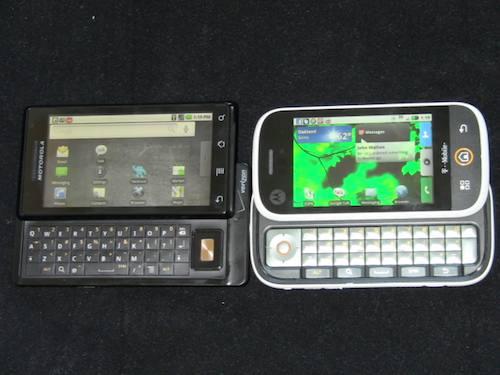
Left: Motorola Droid for Verizon, Right: Motorola CLIQ for T-Mobile. Hint: Droid is the black phone in all photos.
Motorola's Droid is perhaps the most anticipated new smartphone of the season - if not year - and for good reason. The handset marks a number of firsts: Verizon's first Android handset, the first phone to ship with Google's Android OS 2.0, and one of the first two "comeback" phones from Motorola. Droid is also one of the slimmest touchscreen-and-physical keyboard phones in the world (Motorola and Verizon claim it's the thinnest) and is Verizon's entirely unsubtle head-to-head competitor for AT&T and Apple's iPhone, as the carrier's new "iCan't … DroidDoes" ads attest to.
For me, Droid's biggest calling cards are it's massive touchscreen display and that slide-out hard QWERTY. Looking at the Droid/iPhone comparison, Droid should be able to sway many a potential iPhone customer with the mere addition of that physical keyboard. Whether reality or perception, many a smartphone customer claim that they simply can't type on a touchscreen and so continue to eschew iPhone in favor of BlackBerries and Windows Mobile devices with clickable keyboards. Not that there aren't other reasons for eschewing Apple's smartphone, mind you.
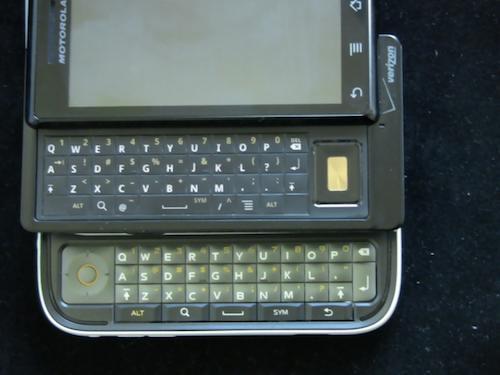
So when I got my Droid review loaner I fired it up, caught my breath when I first glimpsed the gorgeous widescreen (and it is gorgeous) and immediately slid the QWERTY open and started pounding out emails. Five days later and what have I concluded? The keyboard on Droid just isn't good enough for more than the occasional missive, and it's best for short ones at that. I actually prefer Moto CLIQ's hard QWERTY to that of it's higher-end sibling, and I'm not so sure that I don't even prefer Droid's touchscreen keyboard to typing on its buttons.
What's so wrong with Droid's QWERTY? Two things: button size and key travel. The darn buttons on the thing are too small and not very well separated from one another. And the very shallow, chiclet-style action on the keys left my thumbs fatigued after a paragraph or two. That's fine for the occasional SMS or tweet but won't make BlackBerry-level power users very happy over the long haul.
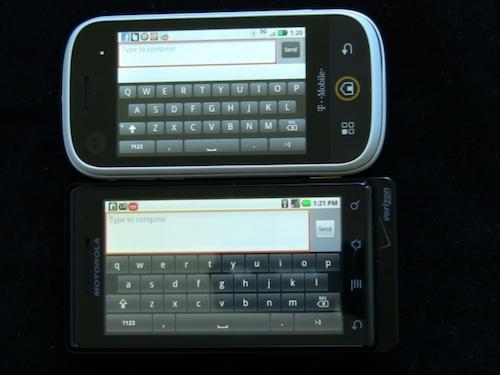
The short key travel is likely an unavoidable side effect of the device's slim profile, but Moto designers could likely have found a way to increase usability via CLIQ-style contoured buttons, an offset key design (as opposed to the grid they used) or even both. To make matters worse, Droid suffers from a bit of "G1 Thumb Syndrome," in that its keyboard is shoved over to the left, which means you have to stretch your right thumb further than is instinctive to reach the keyboard. With G1, the stretch was caused by that device's infamous chin; Moto added a D-Pad to the right side of Droid's keyboard which, while I love the idea of a D-Pad for the eventual torrent of Android games I really hope is coming from big-time game publishers, renders the keyboard unnaturally offset to the left.
For the record, CLIQ also suffers from D-Pad induced keyboard offset, but the effect isn't so bad due to that phone's overall narrower profile. Also, CLIQ's D-Pad is on the left while Droid's is on the right, which makes me think that Motorola is too concerned about product differentiation within their new lineup and not focused enough on top-notch usability from the top of the line trickled right on down to the entry level devices. I mean, if the flagship Droid gets a right-mounted D-Pad, that must be the optimal solution, right? So why shouldn't CLIQ get it, too? Makes no sense.
But it's not like CLIQ's keyboard is a bed of easy to type on roses, either. I may prefer it just a bit to Droid, but it's also too small/cramped and set up in a grid. Offset keyboards, people, offset keyboards! There's a reason modern computers ship with offset keyboards: They're easier to type on!
(NOTE: I know carriers have a lot of input when it comes to handset design, and so Verizon and/or T-Mobile may be as much if not more to blame here than Moto.)
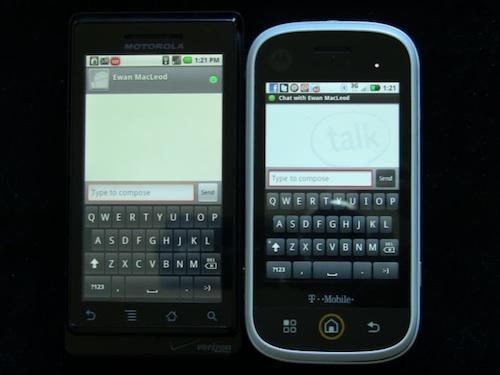
Also, what's up with the two totally empty faux-keys in the bottom corners of the layout? How about dedicated Symbol and Home buttons - or anything - there instead of wasted space? C'mon, Moto, you're better than that!
Anyway, all in all I'd rate Droid's hard QWERTY as "Usable at best." Yes, you can get used to it, but no it's not a pleasant typing experience for the power user. Granted, I'm a bit touchier about such things than your average user, and I'm sure many a soon-to-be Droid owner will like their new phone's keyboard just fine. I'm not saying the QWERTY is a dealbreaker on an otherwise (mostly) excellent smartphone.
But I am saying that in a world full of BlackBerries, Touch Pro2s and even LG enV Touches and enV3s, Droid's hard QWERTY just doesn't pass muster. That's too bad, considering it's the new flagship device for two of the biggest names in mobile: Google and Verizon. It's also too bad considering what a gem Droid is in so many other respects. Ah, well, I guess life is all about compromise.
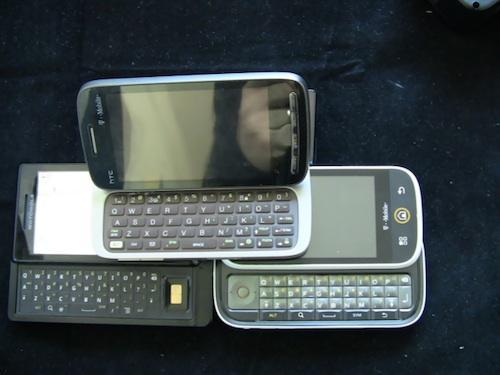
Top: HTC TouchPro2. Now there's a real keyboard. And a really huge phone to house it in.